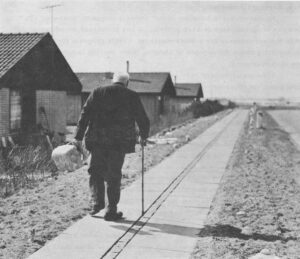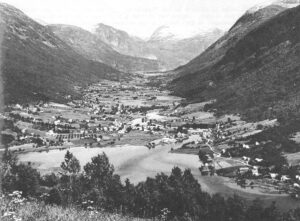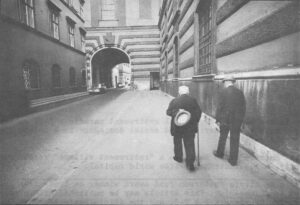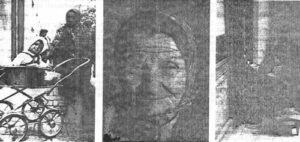Washington, D.C.
April, 1971
At gate four of the “walled city,” a small, white Toyota pauses long enough for the guard to check the bumper identification sticker, glides past flowering plum trees and symmetrical patches of velvety lawn, and eases into a car shelter adjacent to a Spanish-style bungalow.
The car and its driver, Mrs. Edith Wilson, 65, are home again in Leisure World. Safely.
To the uninitiated, to those under the occupancy age minimum of 52, Leisure World in Laguna Hills, California, is the Cadillac of a burgeoning U.S. phenomenon known as retirement villages.
In this one, about 90 auto minutes south of Los Angeles, some 14,000 affluent retirees from around the country have opted for a new life style. They have left behind social and civic pressures of upper-class living and the irritations of noise, pollution, integration and a rising crime rate. In exchange for a lot of cash, they are promised “privacy…security…companionship of people just like you.”
The glossy advertisement also glorifies the “freedom to do what you want, when you want to do it…the discovery of yourself, others, and new interests you never had time to pursue…It’s almost too good to be true.”
One wag finds it so homogeneous he calls it “Larchmont Yacht Club West.”
Mrs. Wilson, a candid mid-westerner, irreverently dubs it “The Resettlement Area.”
“They don’t like to hear that,” she adds, warm brown eyes widening mischievously. “But it does remind me of the part of’ Hong Kong where they stash Chinese refugees.”
She herself chose Leisure World over her adopted state of Hawaii only because of price. Although investment for her two-bedroom condominium was 13,000 dollars and the monthly maintenance is about 220 dollars; it is considered cheap by comparison.
Her “manor,” as the apartments are called, wafts island exotic with its ebony bamboo furniture, pink accents, oriental bric-a-brac, and profusion of flowering plants.
The only architectural concession to age and possible future infirmities are the grab bars in the bathroom, waist-high wall sockets and kitchen counters at wheel-chair level.
“For the security, pleasant surroundings and fringe benefits,” says Mrs. Wilson, “I can live better here on the money I have. And I can turn the key in the door and go off anytime I want to. There are no burglars to worry about and the grass is watered automatically.”
Harold Conklin, a retired executive now in realty sales, says, “It’s no low price deal.” (Costs have risen eight per cent a year and some of the first residents from 1965 have been forced to move into mobile homes elsewhere.) “But for what you get,” he adds, “it’s a terrific way to live.”
For him, that includes getting a doctor within 20 minutes after his heart attack. On the grounds, a new hospital is going up next to the plush 2.2 million-dollar nursing home.
Leisure World means “being with your own kind,” Conklin says. “People you like. Probably more millionaires here than anywhere else.”
The 1,725-dollar entrance fee entitles residents to enjoy a dizzying smorgasbord of clubs, courses and crafts. A typical week’s schedule in the Leisure World News lists about 227 events.
You can join any one of 130 fraternal, service, church and social organizations found back home or try something new like Braille, the British Isles Club, ladies bocce, lapidary, yoga, slip casting, Russian and a hillbilly music combo.
“You can do all or nothing,” says a Lansing, Michigan widow who packs her days with three women’s clubs, swimming, California history, volunteer sewing, day trips to historic sites and the concert, and lecture series.
“I was active ‘back home, too,” she explains, “but there were other reasons for my moving. I had a big house and would get snowed in and have no one to care for it.
“It’s no fun living alone and you begin to worry about security. It’s wise when you can still manage to think gradually about making a change.”
The change includes a decorator-furnished duplex and a prominently displayed Cambodian rubbing, one souvenir of many recent jaunts.
A “roommate,” a cousin from Mt. Vernon, Iowa, and also widowed, put security as her top priority. “Here,” she says, “I’m not afraid to go out.
“But I do miss the interaction of younger people and male evenings with my husband,” she admits. Smoothing, the skirt of her conservative brown knit suit, she adds, “When you are young, you think you’ll live forever. When your husband dies and you are on your own again, you do a new life. You don’t look back and regret.”
Does she think about remarriage? Maybe with one of those millionaires out on the golf courses, jogging in a new “sexercise” program, or checking the board at Goodbody’s brokerage down at the shopping center?
Amused, she quickly retorts, “He’d have to look very good to me. I’m not going to take care of an old man.”
Young Lynn Walker, a waitress at Granny’s Red Skillet coffee shop admires their enterprise. “They’re not quitting,” she says. “They’re raring to go and keep saying they feel sassy.”
Little of that vitality is evident at night.
At nine in the evening, Leisure World is wrapped in stillness. Streets are deserted except for an occasional auto cruising home at 15 m.p.h. Here indeed is the movie set perfection of an orderly adult world. The outsider misses the shouts of youngsters at play, the hastily dumped bicycle left on the lawn, the activity of a corner delicatessen or drug store.
At nine in the morning, the sun is out, but residents are not. A few men in 10-gallon hats and string ties walk their dogs. Maybe others are inside the community hall for bowling, beginning bridge or ballroom workshop. There’s some bustle around the golf course and in the shopping center.
There’s a shop to have your diamonds cleaned while you visit the Taj Mahal-style office building for your Social Security and Blue Cross information. The dress shop has a new shipment of Gloria Swanson Forever Young pantsuits.
At the supermarket, shoppers are still incensed that a motorcycle gang crashed the security gate after midnight recently. “And remember that berserk Ford that woke us up some weeks back?” asks one lady.
For super security there’s going to be a new $13 million, 14-story hi-rise for the elderly. For the minimum $20,000 investment, one will have 24-hour medical and maid services, and recreation and meals “just an elevator ride from your private quarters.
“A new way of life for the golden years,” it says in the brochure.
It’s an age-segregated way of life, note sociologists who study these “utopias” mushrooming in Arizona, California and Florida. They see a new subculture of elderly for whom sunshine and leisure are more important than traditional, productive “elder statesman” roles back home.
The trend seems to confuse a younger public sometimes convinced by television and magazine reports that it’s less sun and more sin. A running away. A “cop-out.” Is that what retirement should be – a lot of old people together?
For those who choose it and can afford it, communities like Leisure World are exclusive, comfortable, convenient and safe.
Housekeeping is simple, neighbors are congenial and you can do as you please.
Surveys show that only five per cent of the estimated 20 million U.S. aged live in retirement communities. They are probably the only ones who can afford it and also have good health. They tend to have no children, or few family ties to keep them at Home.
By comparison, a poorer individual migrates only for reasons of health.
John Sherwood, 82, a retired shoemaker from Oseola, Nebraska, came to Van Nyes, California, 12 years ago because of asthma.
“Hardest job I ever had was to retire,” he says, during a flight from San Jose to Los Angeles. (First plane ride, he confides with boyish pleasure as he sits throughout the trip wearing his gray Stetson and holding tightly onto the armrests.)
“Walked 150 miles in four months out here,” he says in his flat twang. “Hard to make friends. I have two daughters and great great-grandchildren here, but since the wife died last year, I go back to Nebraska every spring. Twelve hundred people in the hometown and you knew everybody.
“Miracle to stay up in the air, isn’t it,” he adds, gray eyes shining through thin red-framed spectacles.
In the sociologist’s lexicon, Sherwood is a “snow bird,” one who goes to warmer places in the winter and returns home in the spring.
Gordon Bultena of Iowa State University says there is no universal solution to the problem of retirement living. But he is sure that the Leisure Worlds “are not ghettos of ill-adjusted, frustrated and alienated old people. They simply prefer consumer roles and the psychological climate and facilities of’ such a place.”
Maybe they are “escaping from a larger system which excluded older persons from the mainstream of social activity,” he adds.
Then don’t condemn the means of escape, but the “general societal patterns which make such escape desirable today…for many older persons,” he concludes.
“Our society prizes qualities of beauty and aggressiveness,” says public relations executive Kevin O’Connor, 25.
“When they are gone, the individual feels ostracized and goes to a reservation called a golden age village. Sadly, because of science and improved health, some at 65 are actually more able than those of 40.”
The trauma of retirement is acute for those, whose whole world revolves around a job, says Dr. Eric Pfeiffer of Duke University. In our society you are first a name and then a job. Take away the job and you are nothing, he adds.
Ninety per cent of older persons interviewed for a survey about leisure said they would still work if they could. Another 51 per cent said they got more satisfaction out of work than non-work.
For an instant self-evaluation, Pfeiffer suggests you recall the last time you had fun. If it was-at work or work-related, look out.
Leisure, he concludes, is not a popular subject.
Even so-called senior citizen centers make a fetish of the work ethic. One must do something; make something practical, something like potholders or ashtrays which one might sell. At one center in North Carolina, retirees are paid to feel useful and are taught to make centerpieces out of discarded funeral wreaths.
Federal projects employ the elderly as babysitters or day laborers and advertise it as a “new chance …to maintain dignity and respect.” That it is through work and something tied to a paycheck is self-understood.
Sociologist George Maddox of Duke University chides society for “failing to provide learning and recreational opportunities for the elderly to the same degree as for the young. For failing to provide alternative means to maintaining self-esteem.”
A 35-year-old television writer wanders through Mac Arthur Park and panics about being unproductive some day.
Looking around at elderly Hollywood types who now live in dismal one-room flats fringing the park, he says, “I see these people here and it makes me fearful I’ll end up that way.
“I’m doing okay now and buying some real estate.
“None of those $200 suits for me,” he says, tugging at the sleeve of his Mickey Mouse T-shirt. “Got a buddy who flies to Chicago for a weekend to be with some chick. Why spend the money?
“Only other thing I’ve done is radio. Who wants to be a 50-year-old disc jockey?
(“Of course I worry about getting old,” says little Lucy in the Charles Schultz “Peanuts” cartoon. “Who wants to be nine?”)
Who wants to grow old and perhaps become a burden?
“Older adults have been taught,” says Dr. Margaret Clark, an anthropologist in San Francisco, “that dependency, except in young children, is weak, psychopathic, immoral or un-American.”
It’s the gospel of the bootstrap, she adds, with the poverty of others as signs of improvidence and failure. These critics, however, will one day also really need other people.
But if they do, says Dr. Clark, they prefer to pay for the services – to enter a nursing home rather than burden one’s children. Or one prefers a retirement community.
Being among one’s peers also provides insulation against the insults of society.
“Can you explain to me,” asks an older female voice over the telephone, “Why do they always refer to us as ‘little old ladies in tennis shoes’?”
Another septuagenarian, visibly shaken, laments to her minister that two youngsters had blocked her path one morning and taunted her with, “Hello little old lady. You’re not so strong. Bet we could knock you over and take your purse. What could you do about it?” Laughing, they skipped away.
Muggings, purse snatchings and rape of elderly individuals are increasing in communities around the country.
Dr. Leroy Leavitt, Dean of the Chicago Medical School, notes the lack of good inter-generational relationships with some concern. Instead of youth having some appreciation of life span and what it means, they share their own parent’s intolerance, he says. The occasional visit from grandmother prompts an “Oh my God, here she comes now.”
Jane Carothers, a vivacious redhead in her forties, directs a thriving drop-in center for the aged in Cincinnati. She blames media for “this sickening golden age stuff.”
“The image has got to be changed. These wonderful, intelligent individuals are constantly pictured at play wearing silly hats or in awkward positions,” she says.
“The kids see that and think ‘yak,’ instead of knowing that dignity and the great facing of life is what aging is all about.”
Paul Lawton, ecological psychologist at the Philadelphia Geriatric Center, feels the middle-age segment of our population sets the tone of callous indifference toward the older adult. One stemming from fear.
“Aging means slowing down, becoming inactive and eventually dying,” he explains. “Activity is the goal of everything in our life. And the idea that we ourselves will be unable to maintain activity is anxiety arousing.
“We define successful aging in middle-age terms. Picasso is an ideal aged person because that is how we want to be. Active. We see as unsuccessful the man who segregates himself with other older persons, who prefers to be alone, because it’s not what we would do.”
Our disregard for the changing needs brought about by aging is most evident in city planning and architectural design.
Students in an architecture seminar at the University of California at Berkley simulated infirmities of aging and documented obstacles in the city. They found a dearth of benches; awkward stoops and curbs; fast walk lights, small-print signs and poor transportation arrangements.
One concerned student badgered city officials until they agreed to re-time two traffic lights. (In Cincinnati, a similar request to the city manager elicited a terse suggestion to walk faster.)
Portland has a beautiful new fountain, says Louis Gelwick, architect at the University of Southern California at Los Angeles. “But the elderly can’t enjoy it because there’s no place to sit and the area lacks toilets and snack bars. So they don’t come. It’s too much effort.
“A younger person,” he adds, “jumps over a temporary physical or social obstacle. The aged does not.” Discouraged and intimidated, the individual decides to stay home and becomes further withdrawn and isolated from the community.
Architects still joke over an expensive hi-rise for the aged in San Francisco. The first mistake, they say, was to build it on the edge of a black ghetto. Residents never venture out because they’re afraid to walk in the area. Secondly, the designer forgot that two high towers placed together creates a draft. It tends to blow over old ladies coming out of the lobby.
Gelwick claims nursing homes can also “mess you up.”
“Unless you have money, you can’t project your personality via your own furniture and belongings,” he says. “Left with only four sterile walls and a bed in one corner, you eventually lose track of who you are.”
At the Philadelphia Geriatric Center, Lawton manipulates the environment to rehabilitate senile patients; those usually relegated to the “vegetable bins” of state hospitals.
Here in a unique and successful experiment, 44 individuals are kept oriented to time, place and selves via mirrors, giant calendars and clocks, bulletin boards, photographs and personal mementos. And a caring staff.
Patients are dressed and walked, sit near one another at mealtime, and are trained into continence. Mind and muscle are stimulated with simple projects: stiff, gnarled fingers slowly feed bits of colored, raveled yarn into an animal cutout. It may be a present for some great-grandchild.
This humane approach to the span of aging facilities at the Center (serviced apartments, hospital, nursing home, senile ward) is in the Jewish tradition of caring for one’s own. The sign over the main entrance reads: Honor thy mother and thy father.
Some universities with gerontology departments are also experimenting with new types of facilities and services for the older adult. At the University of Syracuse, students in the School of Social Work are running a hi-rise for the elderly.
When the city wanted to build such a low-income project, Dean Walter Beattie jumped at the chance of having it on campus next to an undergraduate dormitory.
“In designing cities,” he says, “we deal out the older person as a viable member of the community and deny him the right to participate and communicate. It’s a social question. Not an economic one.” To rectify the situation, Beattie proposes that the federally sponsored Model Cities Program use school buildings as evening community centers. He also feels the university should participate more in community life.
His theories find some practical application in the 24-story Toomey Abbott Towers built in 1969. The 450 residents have access to campus activities, some courses, and, naturally students.
Some warm friendships have developed. “I used to think the elderly were catatonic and silent in their rocking chairs,” says Maureen Lebel, a graduate student who plans their services and recreation. “By the time I got engaged, I was dying to have some of the residents meet my fiancé. Now when Sybil invites me up for a beer, my husband jumps at the chance too, and says ‘Okay I’ll bring the pizza’.”
Residents don’t seem to mind being captive case studies in gerontology. “The resident council has a say in what we do,” says Bruce Thompson, project director. “If they want us to leave, we’ll go.”
“Right now,” he adds, “We’re concerned about 163 isolated individuals in the building who don’t participate in activities. We want to find out if it’s because our old ways of communicating are bad.”
Toomey Abbott Towers is one way of bridging the gap between theory and practice. Between the academic ivory tower and the “real” world.
Thompson, a recent social work graduate, is concerned about those who study aging, a relatively new academic subject, but don’t “see” the individuals. He describes a summer gerontology seminar dealing with intelligence and brain waves, “while three blocks away old people pushed out by urban renewal were moving their belongings in a wheel barrel. No one offered to help them. It didn’t seem right to me.”
Dr. James Birren, director of the Gerontology Institute at the University of Southern California at Los Angeles, says the role of the university is in research and training, not in operating day centers for the elderly.
Rather, one schools individuals in various aspects of aging-sociological, psychological and biological-then lets them “infiltrate” organizations and professions dealing with practical services.
The institute offers the only undergraduate gerontology program in the country and plans to introduce the curriculum into local high school science courses. “So young people can view the human being as having a whole life span possessing different challenges,” says Dr. Birren.
The other major gerontology center and the oldest in the U.S. is at Duke University.
Until the recent past, gerontology has had the same rough road to tread as the elderly themselves.
Dr. Birren describes it as “academic aversion to the subject matter. Old heroes were interested in only young organisms. To date, only half of our medical schools have any mention of aging. Yet half of the patients are over 65.”
(In a sardonic aside, Dean Leavitt says, “There’s more money in being able to do heart transplants than in treating the elderly.”)
The dearth of interest and money explains the underdeveloped stage of services and trained personnel in the U.S. “Under our laissez-faire system,” says Dr. Birren, “you build services for those who can pay for them. There was no financial base until the advent of Social Security and Medicare to build institutions.”
Two unique clinics at Duke University attract aging persons from around the country and also Canada.
Those over 50 can get a complete inpatient geriatric evaluation. In one case a man with premature senility is getting experimental treatment with hyperbaric oxygenation. Here one gets the counsel of the top geriatric medical researchers and teaching-physicians.
Some also offer their skills, where pertinent, to the information and counseling center.
There, retired individuals (running the gamut from unskilled laborer to a professor of English) try to figure out “Where do I go from here?”
Mrs. Grace Polansky, a social worker and interviewer, says 41 per cent of the problems are emotional. She describes an Atlanta widow, a heart patient with only Social Security as income. The woman was fighting depression and loneliness, and agonizing over whether to live alone or with a daughter in Greensboro or another in Tampa.
“You talk out the alternatives,” says Mrs. Polansky, “and then find it doesn’t look so black. When you’re not happy and active, where do you go but inside.”
Incidentally, if you’re interested in living to a healthy and ripe old age, “life satisfaction” is the key, according to Duke researchers. Not heredity.
At the National Institutes of Health in Baltimore, the federal gerontology research center, Dr. Nathan Shock is more interested in the biological aspects of aging. He is not looking for a miraculous youth pill, but for better health in aging.
“Everyone is going to get old,” he says. “You can’t stop the aging process. But how is important. Why not find out what we can about it?”
Thus far his longitudinal studies show it’s important to eat less and to stop smoking.
How much more we will learn is up to the Administration. Dr. Shock says federal supports have been cut in half and “research pretty effectively downgraded. Again, aging is considered the end of the road and not worth the investment.” Currently, the government spends an estimated five cents per person on aging research.
Dr. Karl Eisdorfer, chief of Duke University gerontologists and president-elect of the U.S. Gerontology Society, wants to stem the tide of “ignorance” and “under planning” in the field of aging.
“Our basic thinking hasn’t changed much since the days when the Eskimos put their old people out on ice floes,” he says.
He derides the “middle class approach” geared to the 19th century theory of putting the elderly in institutions – “out of sight and out of mind.”
As “evidence of personal anguish,” he cites suicide statistics: The incidence for woman at age 85 is 59 per 100,000; for men, 14 times that number.
Dr. Eisdorfer also says, “The major affliction of old age is not sickness. It’s poverty.”
Statistics show that 47 per cent of single or widowed individuals live below the poverty line. Among them are 11 million widows.
The sole income for most is Social Security; private pensions account for only 5 per cent of all retirement income.
Economist Juanita Kreps of Duke University champions a “double-decker” solution to the income problem. It would provide a guaranteed income up to poverty level of 1800 dollars for a single aged individual and 2200 dollars for a couple. In addition, there would be Social Security benefits automatically adjusted to wage increases.
Dr. Kreps knows from having testified at numerous government hearings that the proposal is not a popular one.
Part of the problem is our ambivalence about “hand-outs.” One is supposed to have saved enough for retirement or else is judged a failure. Little consideration is given to factors of escalating prices, which wipe out even substantial savings if one lives long enough. “Retirement schemes,” says Dr. Eisdorfer, “are geared to the invalid proposition that one dies at 72.”
The Social Security part of the picture is tied up in party politics says Social Security analyst Dr. Paul Fisher. An increase, he explains, depends on the largesse of Congress and is used as vote-getting technique.
“Elsewhere in the world,” he says, “retirement is a right and pension monies provided. In the U.S. it is a right to die fast.”
A Social Security Administration bulletin estimates that by 1980, 70 per cent of retired couples will have benefits of only 2,000 dollars a year.
“If pension systems are to be used to eliminate poverty,” it notes…”Significant changes in present U.S. pension systems must take place.”
Sociologist Irving Rosow wonders…”Just how pressing old people’s problems would be if their present incomes were simply doubled or trebled. And they had the freedom of action in the market which they are now denied.”
If that freedom means wanting to live in a Leisure World, sociologists concur that the elderly should have that option. Now, without money, they don’t.
No one expects a solution to the round robin at the White House Conference on Aging, which will take place in November. Various members of state commissions on aging dismiss the con5arence as “rhetoric”. “Only those issues will be discussed that suit the Administration,” says a Chicago official. “We wouldn’t spend all our money and efforts organizing for it if we didn’t have to.”
Hobart Jackson, administrator of the Stephen Smith Nursing Home in Philadelphia, says the Conference is “predetermined, prearranged and prestructured.”
In protest, he is organizing gerontologists in a counter-ploy. Jackson says the black aged and other minorities are being dealt out of the White House Conference so he’s planning a “Black House Conference.”
“The potential rests in coalition,” says the black leader. “We need an overlap of militant minorities. We’re dealing with the weak who need advocates to help them get mobilized.”
Black Power fused with so-called Senior Power could help surface the aging problem. Congressman David Pryor, of Arkansas, says only the “tip of the iceberg” is now visible. “I don’t think the House realizes that the problem of the elderly is of’ crisis proportion.”
Historically, the aged have been ignored by politicians because “they don’t complain and they don’t vote,” explains a Senate aide. The tide may be changing.
Major Roy Nordheimer, 83, and president of a Council of Senior Citizens in Chicago, says the future of the aged lies in pressure groups.
“If we ever get ourselves properly organized,” he says, “if we make enough fuss, we would get things done.”
Maude Easter of the Community Chest in Syracuse is helping the elderly become politically active. It’s difficult, she says, because they’re not used to speaking out and lack confidence since they’ve been out of the job market.
There’s no activity among the four million rural elderly although they have the greatest needs. U.S. Senate hearings indicated that 75 per cent of them need some help with income, housing, health and transportation.
Because they lack the labor union traditions of city workers, getting organized is considered “inappropriate behavior.”
The Administration ignores them, says Jim Lewis, Jr., of Little Rock, Arkansas, because there is no longer a powerful rural farm block. “That’s why the rural depend on our organization to do something for them.”
Lewis represents Green Thumb; a project set up by the Farmers Union to employ low-income rural elderly. The government foots the bill.
Retirees work part-time at minimum wage to build parks and recreation facilities in a number of farm states.
A dozen such persons helped revitalize a hamlet in the Ouachita Mountains of Arkansas at a total cost of less than 15,000 dollars. As they tell it, shingle splitters, carpenter and electricians, one of them well over 80, put aside snooker pool and catfish fishing. Instead they rebuilt a community hall, garage for the school bus, set up a Little League ballpark and introduced a school lunch program.
Thus in scattered projects around the U.S., individuals are trying to find ways of giving meaning to life in later years.
It is mostly a matter of “doing for” an aged population disadvantaged in education and skills. Many were foreign born.
Sociologist Bernice Neugarten predicts the next generation of elderly will be better educated and more demanding.
It will be a group schooled in the politics of confrontation.
Demographers say the aged population will reach the 45 million mark in the next 50 years. And the control of disease will increase life expectancy to 100 years, swelling the elderly proportion of society to 25 per cent.
What then of the problem of “age-ism” (defined by Dr. Robert Butler, a Washington psychiatrist, as negative attitudes toward an age group other than one’s own)?
Dr. Neugarten says, “Future forms of age-ism may be one of the ‘sleeper’ problems of our times, perhaps in the way that race relations was a sleeper problem 20 years ago.”
She foresees a “struggle for age rights.
“Not only…of the young. But also of the old.”
Received in New York on April 19, 1971.
©1971 Nada Skerly
Nada Skerly is an Alicia Patterson Fund award winner on leave from The Cincinnati Post and Times-Star. This article may be published with credit to Miss Skerly, The Cincinnati Post and Times-Star, and The Alicia Patterson Fund.











